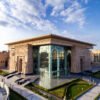Egypt is a land where ancient history breathes under a modern sun, a destination that promises awe, wonder,…
The Nile is more than a river. It is the lifeblood of Egypt, a timeless artery that flows…
The majesty of the Pyramids of Giza is not just a sight; it is an experience that transcends…
Egypt—a land where time stands still, and history whispers from every corner. From the towering Pyramids of Giza…
The world is counting down to one of the most anticipated cultural events in modern history — the…
Egypt, a land where history is not just read in books but etched into colossal temples and whispered…
Cairo is a city that assaults the senses in the most glorious way possible. The call to prayer…
The timeless allure of ancient Egypt—a land of pharaohs, colossal pyramids, and the life-giving Nile River—beckons travelers from…
The world’s gaze fixed on Egypt in October 2025, as the ancient land of pharaohs once again became…
Egypt. The name itself conjures images of colossal pyramids piercing a desert sky, golden treasures of boy kings,…
The monumental silence of the Giza Plateau, the colossal gaze of the Sphinx, and the mystical, eternal flow…
For Canadian travellers dreaming of golden sands, monumental temples, and a river that has nurtured civilization for millennia,…















